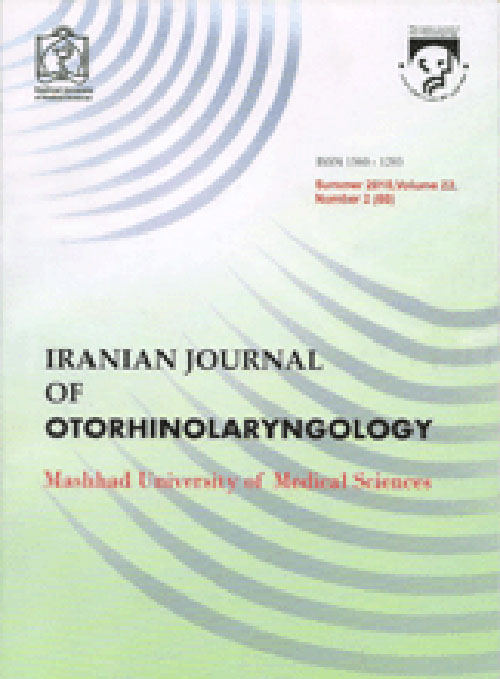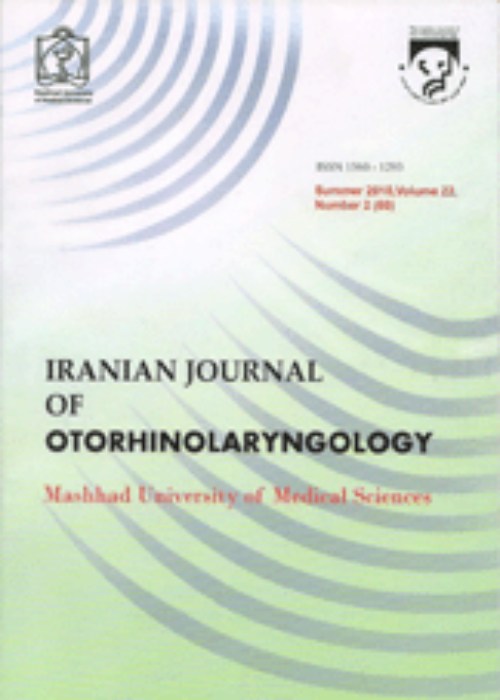فهرست مطالب

Iranian Journal of Otorhinolaryngology
Volume:34 Issue: 2, Mar-Apr 2022
- تاریخ انتشار: 1400/12/22
- تعداد عناوین: 10
-
-
Pages 71-81IntroductionThe main goal of our study was to describe the transcription factor (NF-κβ), angiogenetic factor (VEGF), and remodeling markers (MMP-9 and TIMP-4) of the cholesteatoma tissue compared to control skin tissue. There are still uncertainties how transcription, angiogenetic and remodeling factors affect the cholesteatoma course.Materials and MethodsEight cholesteatoma tissue specimens were retrieved from children, seven – from adults, seven skin controls – from cadavers. Obtained material immunohistochemically were stained for NF-κβ, MMP-9, TIMP-4, VEGF. Non-para metric statistic methods were used.ResultsA statistically significant higher numbers of NF-κβ and TIMP-4 immunoreactive cells in the cholesteatoma compared to control group. A very strong positive correlation between MMP-9 and TIMP-4 was seen in the patient group. A strong positive correlation - between MMP-9 in matrix and MMP-9, VEGF in perimatrix, between TIMP-4 in matrix and TIMP-4 in perimatrix, NF-κβ in the matrix and VEGF; between TIMP-4 in perimatrix and NF-κβ in the matrix.ConclusionsCorrelation between MMP-9 and TIMP-4 suggests that TIMP-4 in cholesteatoma tissue intercorrelates to MMP-9. TIMP-4 likely regulates the development of cholesteatoma. Disbalance between MMPs and TIMPs affects NF-κβ and causes uncontrolled cell proliferation and immune response in this tumor. There is a lack of VEGF strong expression in cholesteatoma perimatrix.Keywords: Cholesteatoma, Transcription factor, Metalloproteases, Vascular Endothelial Growth Factor
-
Pages 83-88IntroductionPatotidectomy is the treatment of choice for superficial parotid gland lesions. The present study aimed to assess the facial nerve status, as well as peri-and postsurgical complications, in two surgical techniques (antegrade and retrograde) for parotidectomy.Materials and MethodsThis study was conducted on 56 patients diagnosed with parotid neoplasms from 2013-2015. The patients were randomly assigned to two groups of antegrade and retrograde. In the retrograde group, the dissection was performed initially to expose the facial nerve branches, while in the antegrade approach, the facial nerve trunk was exposed initially. Different values, such as intraoperative bleeding, mass characteristics, and the time for different sections of the surgery, were noted. The facial nerve was examined after the surgery; moreover, hospital stay and drain removal time was also noted. During the six-month postoperative period, complications and squeals were also noted.ResultsBased on the results, antegrade nerve dissection was performed in 24 patients, while retrograde nerve dissection was carried out in 25 patients. The two groups were compared for intraoperative bleeding, drain output, and drain removal time. Hospital stay was found to be statistically higher in the retrograde group (P<0.05). Other complications and morbidities, such as facial nerve trauma, sialoceles, salivary fistulas, Frey’s syndrome, skin sensory changes, and surgery time, were not statistically different (P≥0.05).ConclusionsAs evidenced by the obtained results, retrograde dissection had higher intraoperative bleeding and longer hospital stay. It seems that skin flap dissection is more extensive in retrograde dissection, leading to more bleeding in this approach. These differences, although statistically significant, are not clinically important; consequently, surgeons’ experience and knowledge about the two approaches are of utmost importance.Keywords: Aantegrade dissection, Facial Nerve, Parotid Mass, Retrograde dissection
-
Pages 89-94IntroductionThis study aimed to investigate the serum level of vitamin D in patients with ear cholesteatoma.Materials and MethodsThis cross-sectional study was performed on 62 patients with middle ear cholesteatoma (case group) and 62 patients with simple chronic otitis media (control group). Both groups had the same age (32±1 in the case group and 34±1 in the control group; P=0.973) and gender. Vitamin D serum level was measured in the two groups. Data analysis was conducted using t-test and ANOVA.ResultsAccording to the statistical analysis, a significant relationship was observed between the serum level of vitamin D and middle ear cholesteatoma (P=0.000). The results showed that the serum level of vitamin D was lower in the case group, compared to the control group.ConclusionsVitamin D serum level was lower in the cholesteatoma group. Moreover, it was strongly associated with hearing loss, tinnitus, and vertigo.Keywords: Cholesteatoma, Otitis media, Serum level of vitamin D
-
Pages 95-105Introduction
The present study aimed to assess human leukocyte antigen (HLA) typing differences between smokers with Reinke’s edema and those with laryngeal squamous cell carcinoma (SCC).
Materials and MethodsThe HLA class I, II alleles were examined in 76 unrelated Iranian patients using low-resolution polymerase chain reaction with the sequence-specific primer (PCR-SSP) method.
ResultsThe frequency of the HLA-A*36 allele and HLA-B*35 was significantly higher in patients with SCC. The frequency of HLA-DRB1*01 alleles in Reinke’s edema was significantly higher, as compared to that in others. In the volunteer group, HLA-DRB1*13 and HLA-DRB1*15 were significantly higher.
ConclusionsAs evidenced by the obtained results, HLA-A*36 was significantly higher in SCC, as compared to that in volunteers and Reinke’s edema patients. It can be concluded that being positive for HLA-A*36 increases the chance of SCC by three times. This result should be further investigated in cohort studies conducted on larger samples. Furthermore, HLA-A*24 was significantly higher in the volunteer group, as compared to that in other groups. The HLADRB1*01 was remarkably higher in Reinke’s edema, as compared to that in SCC.
Keywords: Human leukocyte antigen, Hypertrophic edema, Iranian, Polymerase chain reaction sequence-specific primers, Reinke’s edema -
Pages 107-112IntroductionZenker's diverticulum is an acquired sac-like outpouching of the mucosa and submucosa layers originating at the pharyngoesophageal junction. The predominant symptom of Zenker’s diverticulum is dysphagia. Videofluoroscopy confirms the diagnosis. Forestier disease is a clinical entity characterized by ossification of anterolateral vertebral ligament and anterior osteophyte formation along the anterolateral spinal column. Its etiopathogenesis remains unknown and common symptoms are dysphagia, dysphonia and airway obstruction. The objective of this study is to identify a pathophysiological correlation between Forestier disease and the onset of Zenker’s diverticulum.Materials and MethodsA retrospective observational study was conducted. The electronic database of our Radiology Unit was analyzed in order to identify patients with hypopharyngeal diverticulum and osteophytes at the cervical vertebrae level, from January 2010 to January 2021. The search was performed using precise keywords.ResultsThe computerized database search outlined 10 imaging exams: 5 videofluorographies and 5 computed tomography scans. In 100% of the cases, dysphagia was the main symptom that led to the diagnostic assessment; 30% of patients, on the other hand, reported dyspnoea. From the data analysis, the male / female ratio is 1: 1 and the average age of the patients is 64.8 (+/- 11.31) years.ConclusionsWe assume that the anatomical abnormalities in Forestier disease may cause an increase of pharyngeal pressure and consequently support the development of the Zenker’s diverticulum. Hence, it is always recommended to investigate the presence of Zenker’s diverticulum in a patient with Forestier disease, especially for the life-threatening complications of Zenker’s diverticulum.Keywords: Diffuse Idiopathic Skeletal Hyperostosis, Dysphagia, Zenker’s diverticulum, Esophageal diverticulum, Forestier disease
-
Pages 113-120IntroductionThe study aimed to compare the intra-individual 2 procedures of tonsillectomy (Coblation and diode laser) concerning the operative time, the amount of blood loss, postoperative pain, and other complications.Materials and MethodsA comparative study was conducted at many Private Hospitals, Baghdad, Iraq from February 2019- February 2020. Coblation and diode laser tonsillectomy were performed on the same patient (one for each side) which was blinded to the patients or their caregivers and the surgeon who did the tonsillectomy. A double blinded randomization process of 1 to 1 of these two procedures according to the side involved was performed. Data concerning the age, gender, indications for tonsillectomy, operative time, the amount of the blood loss, post-tonsillectomy pain by VAS scores, and other complications were recorded for each patient.ResultsOut of 62 participants, there were 34 (54.8%) females. The majority were from the age group ≤18 years (n = 54, 87.1%). The operative time and amount of the intraoperative blood loss were significantly lower in the Coblation than a diode laser tonsillectomy. However, the postoperative pain scores in the diode laser were a statistically significant difference less than the Coblation group at the periods 3 hours, 8 hours, 24 hours, and 7 days (P-value < 0.05).ConclusionsCoblation was better than diode laser because of shorter operative time and less intraoperative blood loss. However, the diode laser technique had lesser postoperative pain at the postoperative periods 3 hours, 8 hours, 24 hours, and 7 days than Coblation.Keywords: Coblation, Diode laser, Tonsillectomy, Comparative Study
-
Pages 121-125Introduction
A congenital cervical mass is a considerable health problem worldwide; however, accessory tragus (AT) in the neck is extremely rare. The cervical variant of AT or congenital cartilaginous rest of the neck (CCRN) is a rare anomaly related to the branchial arch located at the lateral of the neck that typically presents as an asymptomatic papule or nodule along the anterior border of sternocleidomastoid (SCM) muscle. It is detected since birth or in the first few years of life. Diagnosis is based on the clinical characteristics of the lesion, surgical findings, and histopathologic studies.
Case ReportA young man with no underlying diseases or known congenital anomaly was referred by a dermatologist for an asymptomatic pedunculated papule in the left mid-cervical area. Physical examination reveals a firm and mobile papule with a size of 1*1 cm on the anterior middle 1/3 border of the SCM. Radiologic findings illustrated a mass nearby the SCM with a long tract beneath it extending upward. The lesion was finally resected, and during surgery, a long tract was discovered, and histopathologic examination confirmed the diagnosis of a CCRN.
ConclusionsAlthough rare, the cervical variant of AT or CCRN should be considered in a differential diagnosis of benign masses in the neck.
Keywords: accessory tragus, branchial arch, congenital cartilaginous rest of the neck, sternocleidomastoid -
Pages 127-130Introduction
Benign lymphoid hyperplasia uncommonly involves the larynx. Involvement of glottis and subglottis is even rare, considering sparse lymphatic supply compared to supraglottis.
Case ReportA young female presented to emergency with worsening breathing difficulty. After securing the airway, she had found to have circumferential glottis and subglottic mucosa covered firm swelling. Histopathological evaluation of the swelling showed it to be benign lymphoid hyperplasia. Coblation assisted excision of the lesion was done, and the patient became asymptomatic without any recurrence.
ConclusionIdiopathic lymphoid hyperplasia is a very rare entity to present as glottis and subglottic lesions. Probably, it's the first case to be reported in the literature as laryngeal involvement sparing the supraglottis.
Keywords: glottis, subglottis, Tracheostomy, Stenosis, Stridor, lymphoid hyperplasia -
Pages 131-134Introduction
Basal cell adenoma (BCA) is a rare benign epithelial tumour of the salivary gland majorly involving the parotid gland, and rarely the submandibular gland.
Case ReportWe describe a rare case of BCA of the submandibular gland diagnosed preoperatively using fine needle aspiration cytology in a 60-year-old woman presenting with painless submandibular swelling. The surgery went uneventfully, and the histopathological examination confirmed the diagnosis.
ConclusionsBCA can be accurately diagnosed only through histological observations due to its resemblance to various benign and malignant salivary and non-salivary gland tumours, which are difficult to biopsy.
Keywords: Biopsy, cytology, Computed Tomography, salivary gland -
Pages 135-138Introduction
The connection between parotid gland and external auditory canal has long been described throughout the centuries. It can act as a gateway for infectious or neoplastic material to spread between those two structures.
Case ReportTo our surprise, this naturally occurring defect can serve as an option to conservatively treat a parotid abscess. We report a case of a parotid abscess with a concurrent presentation of an ipsilateral ear discharge. The purpose of our study is to highlight a unique process of resolution of parotid abscess through an opening in the ear canal.
ConclusionsIn spite of the fact that the fissure of Santorini is known as the gateway and tunnel for a disease to spread, it has proven to serve as a pathway for disease elimination as well.
Keywords: Parotid abscess, Otorrhea, Fissure of Santorini


